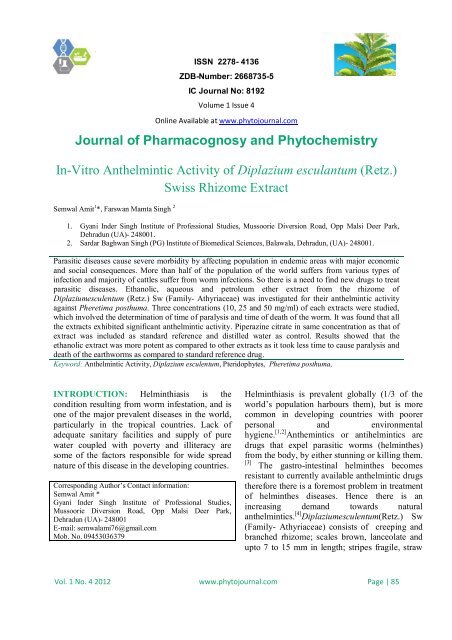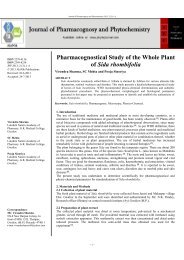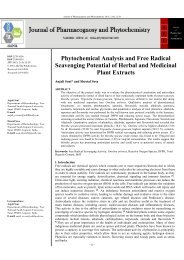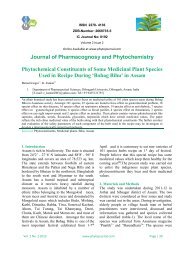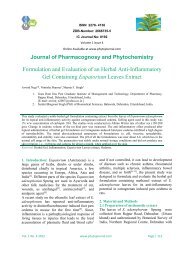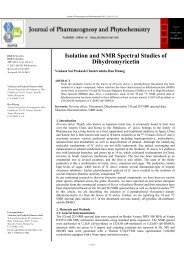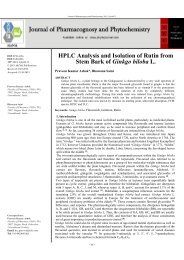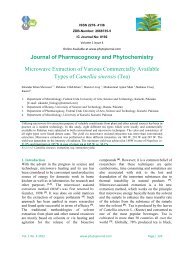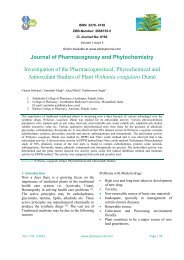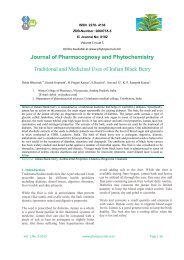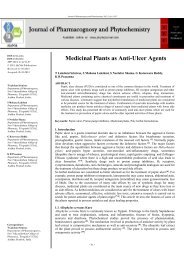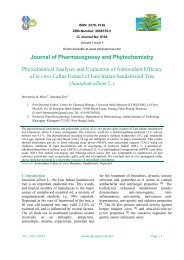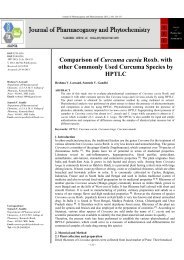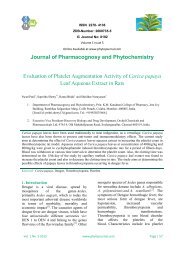Retz. - Journal of Pharmacognosy and Phytochemistry
Retz. - Journal of Pharmacognosy and Phytochemistry
Retz. - Journal of Pharmacognosy and Phytochemistry
Create successful ePaper yourself
Turn your PDF publications into a flip-book with our unique Google optimized e-Paper software.
ISSN 2278- 4136<br />
ZDB-Number: 2668735-5<br />
IC <strong>Journal</strong> No: 8192<br />
Volume 1 Issue 4<br />
Online Available at www.phytojournal.com<br />
<strong>Journal</strong> <strong>of</strong> <strong>Pharmacognosy</strong> <strong>and</strong> <strong>Phytochemistry</strong><br />
In-Vitro Anthelmintic Activity <strong>of</strong> Diplazium esculantum (<strong>Retz</strong>.)<br />
Swiss Rhizome Extract<br />
Semwal Amit 1 *, Farswan Mamta Singh 2<br />
1. Gyani Inder Singh Institute <strong>of</strong> Pr<strong>of</strong>essional Studies, Mussoorie Diversion Road, Opp Malsi Deer Park,<br />
Dehradun (UA)- 248001.<br />
2. Sardar Baghwan Singh (PG) Institute <strong>of</strong> Biomedical Sciences, Balawala, Dehradun, (UA)- 248001.<br />
Parasitic diseases cause severe morbidity by affecting population in endemic areas with major economic<br />
<strong>and</strong> social consequences. More than half <strong>of</strong> the population <strong>of</strong> the world suffers from various types <strong>of</strong><br />
infection <strong>and</strong> majority <strong>of</strong> cattles suffer from worm infections. So there is a need to find new drugs to treat<br />
parasitic diseases. Ethanolic, aqueous <strong>and</strong> petroleum ether extract from the rhizome <strong>of</strong><br />
Diplaziumesculentum (<strong>Retz</strong>.) Sw (Family- Athyriaceae) was investigated for their anthelmintic activity<br />
against Pheretima posthuma. Three concentrations (10, 25 <strong>and</strong> 50 mg/ml) <strong>of</strong> each extracts were studied,<br />
which involved the determination <strong>of</strong> time <strong>of</strong> paralysis <strong>and</strong> time <strong>of</strong> death <strong>of</strong> the worm. It was found that all<br />
the extracts exhibited significant anthelmintic activity. Piperazine citrate in same concentration as that <strong>of</strong><br />
extract was included as st<strong>and</strong>ard reference <strong>and</strong> distilled water as control. Results showed that the<br />
ethanolic extract was more potent as compared to other extracts as it took less time to cause paralysis <strong>and</strong><br />
death <strong>of</strong> the earthworms as compared to st<strong>and</strong>ard reference drug.<br />
Keyword: Anthelmintic Activity, Diplazium esculentum, Pteridophytes, Pheretima posthuma,<br />
INTRODUCTION: Helminthiasis is the<br />
condition resulting from worm infestation, <strong>and</strong> is<br />
one <strong>of</strong> the major prevalent diseases in the world,<br />
particularly in the tropical countries. Lack <strong>of</strong><br />
adequate sanitary facilities <strong>and</strong> supply <strong>of</strong> pure<br />
water coupled with poverty <strong>and</strong> illiteracy are<br />
some <strong>of</strong> the factors responsible for wide spread<br />
nature <strong>of</strong> this disease in the developing countries.<br />
Corresponding Author’s Contact information:<br />
Semwal Amit *<br />
Gyani Inder Singh Institute <strong>of</strong> Pr<strong>of</strong>essional Studies,<br />
Mussoorie Diversion Road, Opp Malsi Deer Park,<br />
Dehradun (UA)- 248001<br />
E-mail: semwalami76@gmail.com<br />
Mob. No. 09453036379<br />
Helminthiasis is prevalent globally (1/3 <strong>of</strong> the<br />
world’s population harbours them), but is more<br />
common in developing countries with poorer<br />
personal <strong>and</strong> environmental<br />
hygiene. [1,2] Anthemintics or antihelmintics are<br />
drugs that expel parasitic worms (helminthes)<br />
from the body, by either stunning or killing them.<br />
[3] The gastro-intestinal helminthes becomes<br />
resistant to currently available anthelmintic drugs<br />
therefore there is a foremost problem in treatment<br />
<strong>of</strong> helminthes diseases. Hence there is an<br />
increasing dem<strong>and</strong> towards natural<br />
anthelmintics. [4] Diplaziumesculentum(<strong>Retz</strong>.) Sw<br />
(Family- Athyriaceae) consists <strong>of</strong> creeping <strong>and</strong><br />
branched rhizome; scales brown, lanceolate <strong>and</strong><br />
upto 7 to 15 mm in length; stripes fragile, straw<br />
Vol. 1 No. 4 2012 www.phytojournal.com Page | 85
<strong>Journal</strong> <strong>of</strong> <strong>Pharmacognosy</strong> <strong>and</strong> <strong>Phytochemistry</strong><br />
coloured, 10-35 cm long, lamina variable,<br />
broadly lanceolate to subdeltoid with acuminate<br />
apex, decompoundly pinnae <strong>and</strong> stalked, distantly<br />
placed, 6-15 × 2-4.7 cm ascending with slender,<br />
naked, greenish rachides, pinnules, upto 15 × 6<br />
mm, sub deltoid, cut down into ultimate oblong,<br />
narrow segments with dentate margin, secondary<br />
rachides minutely pubescent, veins forked; sori<br />
minute, indusium thin, membranous; spores dark<br />
brown.<br />
Time (min)<br />
70<br />
60<br />
50<br />
40<br />
30<br />
20<br />
10<br />
0<br />
Anthelmintic activity <strong>of</strong> rhizome extracts <strong>of</strong><br />
Diplazium esculentum<br />
Conc (mg/ml)<br />
The plant is common in Uttarakh<strong>and</strong> region <strong>and</strong><br />
is frequently used by the Garhwali peoples for<br />
medical purpose. The circinately coiled young<br />
leaves are used as vegetables (lingra). The<br />
rhizome is considered as strong haemoptysis,<br />
used in cough, asthma, phthisis, fever, dyspepsia,<br />
stomachache, diarrhea <strong>and</strong> as antidysenteric,<br />
insect <strong>and</strong> pest repellant. Young tips <strong>of</strong> fronds are<br />
used as tonics for health. Decoction <strong>of</strong> rhizome<br />
<strong>and</strong> young leaves are useful haemoptysis <strong>and</strong><br />
constipation [5-9] <strong>and</strong> used as antibacterial. [10]<br />
Fig-1: Graphical Presentation <strong>of</strong> In Vitro Anthelmintic activity <strong>of</strong> rhizome extracts <strong>of</strong> Diplazium<br />
esculentum against Pheretima Posthuma<br />
Materials <strong>and</strong> methods<br />
The rhizomes <strong>of</strong> Diplazium esculentum were<br />
collected from Shyampur, Rishikesh in<br />
Uttarakh<strong>and</strong> region during the month <strong>of</strong> August<br />
<strong>and</strong> their identity was confirmed by Botanical<br />
Survey <strong>of</strong> India (BSI), Dehradun. The voucher<br />
specimen was deposited in the Department for<br />
future records.<br />
Preparation <strong>of</strong> Plant Extracts<br />
Fresh plants parts were washed 2-3 times with tap<br />
water <strong>and</strong> distilled water <strong>and</strong> then dried under<br />
Paralysis<br />
Death<br />
shade <strong>and</strong> then in oven <strong>and</strong> lastly powdered with<br />
the help <strong>of</strong> an electric grinder. Coarsely powdered<br />
material (500g) was extracted successively with<br />
petroleum ether (40-60), ethanol <strong>and</strong> water by<br />
maceration process at room temperature for three<br />
days. Then all the extracts were filtered <strong>and</strong><br />
concentrated with a rotary evaporator <strong>and</strong> kept in<br />
a refrigerator.<br />
Worm Collection <strong>and</strong> Authentication<br />
Earthworm (Pheritima posthuma) have been used<br />
widely for the initial evaluation <strong>of</strong> anthelmintics<br />
Vol. 1 No. 4 2012 www.phytojournal.com Page | 86
<strong>Journal</strong> <strong>of</strong> <strong>Pharmacognosy</strong> <strong>and</strong> <strong>Phytochemistry</strong><br />
activity, because <strong>of</strong> their easy availability <strong>and</strong> due<br />
to their anatomical <strong>and</strong> physiological<br />
resemblance with the intestinal roundworm<br />
parasites <strong>of</strong> human beings. Indian adult<br />
earthworms (Pheretima posthumad) collected<br />
from moist soil <strong>and</strong> washed with normal saline to<br />
remove all fecal matter were used for<br />
anthelmintic activity <strong>and</strong> authenticated by Head,<br />
Department <strong>of</strong> Zoology, DAV (PG) College,<br />
Dehradun.<br />
Drugs <strong>and</strong> Chemicals<br />
Piperazine citrate (Sharon biomedicine pvt.ltd<br />
Dehradun), petroleum ether AR (60-80), ethanol<br />
AR (CDH Pvt.ltd), normal saline water was used<br />
as control.<br />
Anthelmintic Activity<br />
The anthelmintic activity was evaluated on adult<br />
Indian earthworm. Five groups <strong>of</strong>Indian<br />
earthworms each containing sixearthworms<br />
approximately <strong>of</strong> equal size was used for the<br />
study. Each group <strong>of</strong> earthworms were tested<br />
with different extract conc. (10, 25 <strong>and</strong> 50<br />
mg/ml), distilled water (control), <strong>and</strong> reference<br />
st<strong>and</strong>ard piperazine citrate (10 mg/ml in distilled<br />
water). [10] Time taken to paralysis <strong>and</strong> death <strong>of</strong><br />
individual worms were observed. Time taken to<br />
paralysis was noted when no movement <strong>of</strong> any<br />
sort could be observed. Observations were made<br />
for the time taken to paralysis <strong>and</strong> / or death <strong>of</strong><br />
individual worms. Paralysis was said to occur<br />
when the worms do not revive even in normal<br />
saline water. Death was concluded when the<br />
worms lose their motility followed with fading<br />
away <strong>of</strong> their body colour.<br />
Result <strong>and</strong> Discussion<br />
From the observation made extracts exhibited<br />
more potent activity at higher concentration (50<br />
mg/ml) against Pheritima posthuma (earthworm).<br />
Evaluation <strong>of</strong> anthelmintic activity was compared<br />
with reference st<strong>and</strong>ard piperazine citrate. The<br />
ethanolic rhizome extract <strong>of</strong> Diplazium<br />
esculentum produced dose-dependent paralysis<br />
ranging from loss <strong>of</strong> motility to loss <strong>of</strong> response<br />
to external stimuli, which gradually progressed to<br />
death as shown in Table1. The aqueous extract<br />
showed significant activity, the petroleum ether<br />
extract was the least active among all the extracts.<br />
In the present study, it was observed that the<br />
ethanolic extract <strong>of</strong> Diplazium esculentum have<br />
exhibited positive <strong>and</strong> potent response than the<br />
other two extracts (petroleum-ether <strong>and</strong> aqueous)<br />
even though all the three extracts were endowed<br />
with anthelmintic property. The order <strong>of</strong> activity<br />
was ethanol extract greater than aqueous extracts<br />
greater than petroleum ether extract. The activity<br />
revealed concentration dependence nature <strong>of</strong> the<br />
different extracts. Potency <strong>of</strong> the extracts was<br />
found to be inversely proportional to the time<br />
taken for paralysis/death <strong>of</strong> the worms.<br />
Table 1. Anthelmintic activity <strong>of</strong> rhizome extracts <strong>of</strong><br />
Diplazium esculentum<br />
Test Substance Conc<br />
(mg/ml)<br />
Distilled<br />
Water(Control)<br />
Piperazine<br />
citrate<br />
(St<strong>and</strong>ard)<br />
Aqueous<br />
Extract<br />
Petroleum ether<br />
extract<br />
Ethanolic<br />
Extract<br />
Time<br />
taken for<br />
paralysis<br />
(minutes)<br />
- - -<br />
10 24.18±0.70<br />
Time taken<br />
for death<br />
(minutes)<br />
54.21±0.23<br />
10 22.58±0.79 54.10±0.12<br />
25 16.5±0.42 34.22±1.88<br />
50 12.60±0.25 20.50±1.45<br />
10 32.45±0.14 55.16±1.36<br />
25 20.12±0.62 38.10±1.16<br />
50 18.44±0.55 34.25±1.12<br />
10 16.05±0.68 48.20±1.52<br />
25 8.24±1.44 20.10±0.36<br />
50 5.55±0.50 12.5±0.50<br />
Conclusion<br />
It could be concluded that the ethanolic ectract<br />
showed most potent anthelmintic activity. The<br />
other two extracts e.g., petroleum ether <strong>and</strong><br />
aqueous extracts, exhibited lesser anthelmintic<br />
activity than the ethanolic extract. The present<br />
study revealed that the anthelmintic activity<br />
increases with increasing polarity. Further studies<br />
are required to identify the actual chemical<br />
constituents that are present in the crude extracts<br />
<strong>of</strong> this plant which are responsible for<br />
Vol. 1 No. 4 2012 www.phytojournal.com Page | 87
<strong>Journal</strong> <strong>of</strong> <strong>Pharmacognosy</strong> <strong>and</strong> <strong>Phytochemistry</strong><br />
anthelmintic activity <strong>and</strong> to establish the<br />
effectiveness <strong>and</strong> pharmacological rationale for<br />
the use <strong>of</strong> Diplazium esculentum as an<br />
anthelmintic drug.<br />
Acknowledgment<br />
Authors are thankful to Pr<strong>of</strong>. Kumud Upadhyaya,<br />
Director <strong>and</strong> Mrs Neetu Kainth, Managing<br />
Director, GISIPS, Dehradun for providing<br />
laboratory facilities.<br />
References<br />
1. Tripathi KD, Essentials <strong>of</strong> medicinal<br />
pharmacology. 6 thed. New Delhi: Jaypee<br />
Brothers Medicinal Publishers (P)Ltd; 2008.<br />
2. Chopra RN, Nayer SC, Chopra IC. Glossary <strong>of</strong><br />
Indian medicinal plants. CSIR, NewDelhi,<br />
1956:160.<br />
3. Dwivedi A, Dwivedi S, Sitoke AK, Patel R, Jhade<br />
D. Anthelmintic activity <strong>of</strong> a polyherbal<br />
preparation. Ethnobotanical Leaflets 2009,13:<br />
259-62.<br />
4. Kosalge SB, Fursule RA, Investigation <strong>of</strong> in-<br />
vitro anthelmintic activity <strong>of</strong> Thespesia lampas<br />
(Cav.). Asian <strong>Journal</strong> <strong>of</strong> Pharmacutical <strong>and</strong><br />
Clinical Research 2009; 2 (2): 69-71.<br />
5. Singh HB, Potential medicinal Pteridophytes <strong>of</strong><br />
India <strong>and</strong> their chemicalconstituents, J. Econ.<br />
Taxon Bot, 1999; 23(1):63-78.<br />
6. Bir SS, Key notes address on Ferns <strong>of</strong> India,<br />
their wealth exploration,diversity, growth<br />
conditions <strong>and</strong> conservation, Indian Fern<br />
<strong>Journal</strong>, 1992,(9):IV-VI.<br />
7. Kaushik P, Dhiman A.K., Common Medicinal<br />
Pteridophytes, Indian ferns<br />
<strong>Journal</strong>,1995,(12):139-145.<br />
8. Quisumbing E, Medicinal Plants <strong>of</strong> Philippines,<br />
Manila Dept. Arg. Nat. Res.Bull., 1951;<br />
16(2):174-176.<br />
9. Singh S, Dixit RD, Sahu TR, Some Medicinally<br />
Important Pteridophytes <strong>of</strong> Central India, Int.J.<br />
For. Usuf. Magt., 2003; 4(2):41-50.<br />
10. Semwal A, Kaushik S, Bhatt SP, Negi A,<br />
Antibacterial Activity <strong>of</strong> Diplazium esculentum<br />
(<strong>Retz</strong>.) Sw, <strong>Pharmacognosy</strong> <strong>Journal</strong>, March<br />
2011,(4); 21: 74-76.<br />
Vol. 1 No. 4 2012 www.phytojournal.com Page | 88


